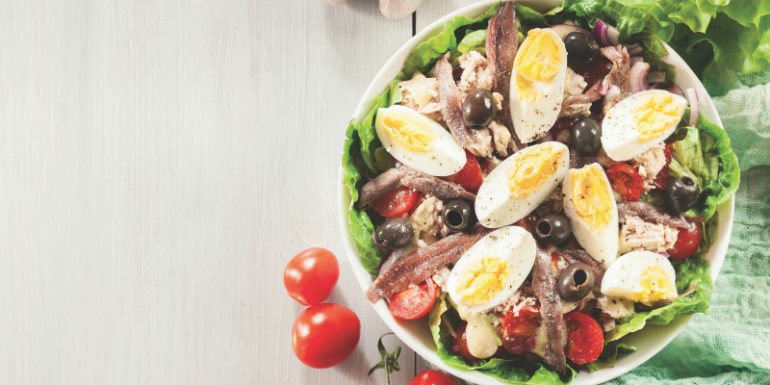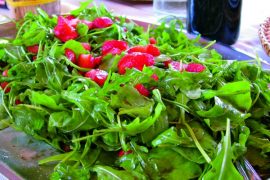By Bill Turner
Sometimes I look at people on the street and think that each one has a story — what do they do, who or what do they like or dislike, have they had great happiness or great sadness. I find myself wanting to know their stories.
Weird as it may sound, the same thing happens to me with recipes, especially with the classic dishes. I want to know their histories. When I do learn them, they’re typically interesting. In this issue we’ll look at two of the most famous salads in the world.
NIÇOISE SALAD
The Niçoise salad originated in Nice, a beautiful city on the southeast coast of France on the Mediterranean Sea, known for its mild climate, beach resorts, thriving arts scene as well as this salad. All the famous chefs have given their own twist to this dish and some, like Gordon Ramsey, have called it the greatest of all salads. The three key ingredients are anchovies, tuna and olives. Nice is famous for all three of these, especially Niçoise olives, a highly prized, small fruity variety. Many good supermarkets with olive bars will have Niçoise olives, so try to get the real thing. Some people will object to the anchovies, so serve those on the side.
Prepping the ingredients is the major hurdle in this salad, but it goes fairly quickly if you have four saucepans, one each for the eggs, the potatoes, the green beans and the beets.
Time Required: 45 minutes | Servings: 6
A Tip Before You Start: To achieve perfect hard-boiled eggs, follow these directions. Remove eggs from the fridge and let them get to room temperature. This will help prevent them from cracking. Bring water to a rolling boil and gently drop eggs in with a large spoon — don’t drop them in. After 10 minutes, use the same spoon to remove them and place them in a bowl filled with cold water. After about two minutes, gently tap and crack the shell on all sides. Start at the pointed end and peel the eggs under running water. The water will get between the shell and the egg and make peeling easy.
Dressing and Salad Ingredients:
The Dressing
- 2 cloves garlic, chopped finely
- 1⁄2 tsp. sea salt
- 1⁄2 tsp. black pepper
- 1⁄3 cup olive oil
- 2 Tbsp. fresh lemon juice
- 1 Tbsp. Dijon mustard
The Salad
- 1 lb. small new potatoes, peeled, sliced about 1⁄2 inch thick and boiled in salted water until tender, about 12 minutes.
- 1 can (14 oz.) beets or 1 lb. of fresh beets. If fresh, cut off stems and boil with skins intact for 35 minutes or until soft. Let cool and squeeze the inside out. The skin should come off cleanly.
- 1⁄2 lb. green beans, ideally French green beans (haricot vert), which are thinner and more tender, blanched for 5 minutes.
- 1 lb. cherry tomatoes, cut in half
- 1 cucumber, peeled and thinly sliced
- 6 radishes, sliced
- 1 bunch of lettuce – any kind will do
- 1⁄2 cup black Niçoise olives
- 1 red onion, thinly sliced
- 1⁄2 cup basil leaves, coarsely chopped
- 8-10 anchovy filets, salt packed if possible or canned in olive oil. Wash and dry with a paper towel.
- 6 hard-boiled eggs, cut in halves or quarters
- 3 (4 oz.) cans oil-packed tuna with excess oil drained off, or 1 1⁄2 lbs. of fresh tuna
Directions:
- Prep all ingredients per instructions above.
- Whisk together all of the ingredients for the dressing and set aside.
- Put some leaves of lettuce on the plate and then use your creative artistry to arrange the salad. Usually the tuna is in the middle, the veggies around the tuna and the eggs (cut in half ), around the edge. Garnish with the basil.
- Pour the dressing over the top and serve, preferably al fresco with a bottle of crisp white wine. I like a cold Viognier.
If you are using fresh tuna, season with salt and pepper and sear in a pan with 2 Tbsp. of olive oil. Try this trick to satisfy everyone’s “doneness” requirements. Buy the tuna in three 1⁄2 pound pieces. Sear the first one for four minutes each side, the second piece for three minutes and the third for two minutes. You can let everyone choose their favorite.
BLUEFIN TUNA IN THE MEDITERRANEAN
The Mediterranean has always been the major spawning ground for the Atlantic bluefin tuna. (The Gulf of Mexico is the other large spawning ground.)
The bluefin pass through the Straits of Gibraltar every spring to spawn and there is a two-month fishing season associated with that ritual. For over 3,000 years the bluefin tuna has been documented as part of the Mediterranean diet. Preservation techniques have included smoking and salting, but for the last 150 years, canning has been the preferred method. In years past, for someone living in Nice, fresh or canned bluefin tuna would be a logical and easily obtained ingredient, ergo, its inclusion in the Niçoise salad.
After World War II the Japanese fell in love with bluefin tuna for sushi, and by 2012 they were consuming over 80 percent of the total catch according to the PEW Environment Group. The love affair has had a strong impact on bluefin availability, which fell 60 percent between 1970 and 2008. Quotas have now been imposed and there has been some stabilization, but this once inexpensive and commonplace ingredient is now a luxury. Canned Mediterranean bluefin tuna, with which most French and Italians grew up with, now costs upwards of $100 per pound and is largely a thing of the past, being replaced by the more plentiful but less tasty albacore tuna.
CAPRESE SALAD
To understand the caprese salad, which appears on the majority of menus in Italian restaurants, we need to think of ourselves floating over southern Italy in the Compania region, a good 150 miles south of Rome. Think of sunshine, warmth, field after field of ripe tomatoes and — wait a minute — water buffalo. Where did these guys come from?
They’re everywhere! We pass over Naples heading south, nearly crash into Mt. Vesuvius and then come to Sorrento (sounds like a song title). And right off the Sorrento peninsula we see the famous Isle of Capri, where our salad was supposedly invented.
I suspect there is no specific reason that the dish was named after the Isle of Capri, but there is a definite reason that it would logically originate in the Campania region of Italy. The two most important products of the area are the unbelievable buffalo mozzarella cheese and San Marzano plum tomatoes grown in the volcanic soils at the foot of Mt. Vesuvius. In both cases, you can’t find better examples of these ingredients anywhere in the world.
Buffalo mozzarella can be hard to find and is often very expensive. However, Whole Foods and Trader Joe’s now carry these glorious delicacies at reasonable prices, and most supermarkets will get them for you if you ask. It is a world apart from regular fresh mozzarella. As the Italians say, “Buffalo mozzarella is not a cheese. It’s a religion.”
Time Required: 15 minutes | Servings: 6
Ingredients:
- 6 small ripe tomatoes
- 1 lb. buffalo mozzarella
- Good quality extra virgin olive oil
- Good quality balsamic vinegar
- Handful of basil leaves
- Salt and pepper
Directions:
- Slice the mozzarella as thinly as possible.
- Cut the tomatoes into normal slices.
- Arrange alternate slices of tomato and mozzarella on the serving plate.
- Add salt and pepper to taste.
- Tear the basil leaves into about four or five pieces and sprinkle on top of the salad.
- When ready to serve AND NOT BEFORE, add a few dashes of balsamic vinegar and about 2 Tbsp. of olive oil.
Make sure you get the right ingredients, add a bottle of chardonnay or sauvignon blanc to the agenda, and you have everything you need for a spectacular lunch for the special people in your life. You will set the stage for a wonderful afternoon.
ITALY’S WATER BUFFALO
Nobody knows how the water buffalo got to southern Italy. Some say they arrived from Mesopotamia at the dawn of civilization. They only thing we know is that they have been there for over 1,000 years, constitute the backbone of the dairy herds of the region and have made Italy the world’s largest producer of buffalo mozzarella.
This cheese is vastly superior to mozzarella made with cow’s milk and there is a reason. Buffalo milk has 7.5 percent milkfat, while whole cow’s milk has only 3.25 percent. It takes five gallons of buffalo milk to make a pound of cheese while it takes eight gallons of cow’s milk. Buffalo mozzarella is an incredibly creamy fresh cheese that, once tried, makes you wonder why anyone would use anything else in a caprese salad.





